Japanese Origami: The Art of Paper Folding
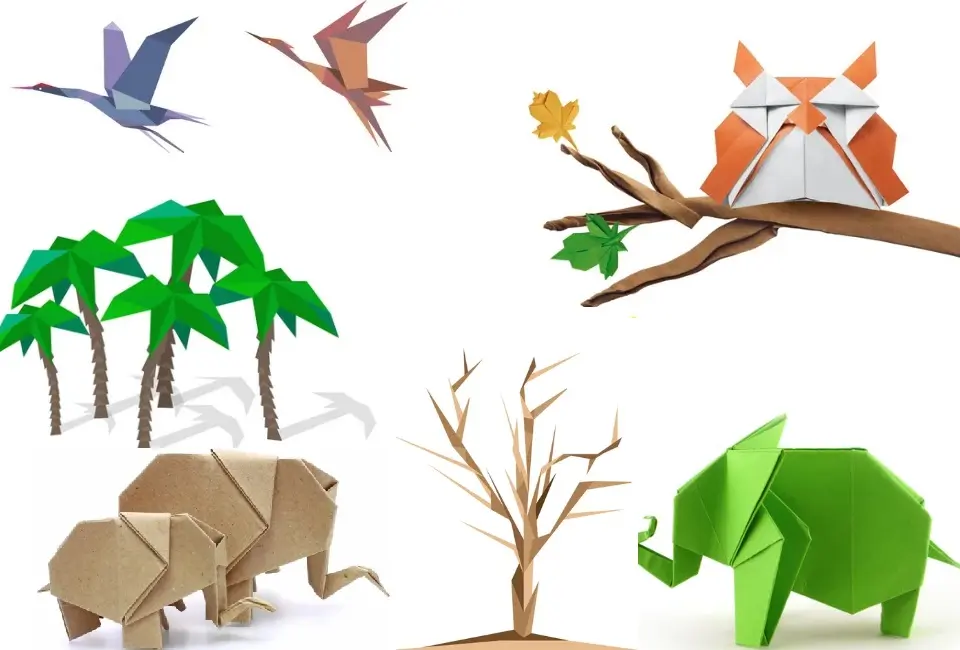
Origami (折り紙), the beautiful and delicate Japanese paper folding art, is to create beautiful shapes and models. This ancient and time-honored art possesses a rich, vibrant, and somewhat mysterious history transcending time and borders.
The word Origami has two parts, ‘Ori‘ (折り), meaning to fold, and ‘Kami‘ (紙), meaning paper. However, Kami here becomes ‘Gami‘ because of the Rendaku phenomenon.
Origami art form today, popularly associated with Japanese culture, has roots that are speculated to trace back to ancient civilizations.
However, Origami’s evolution over time and the particularity of its existence in Japan make it a compelling tale of artistic expression. This article will discuss the history of origami, its influences, its different types, and how to learn and master it.
History and Evolution of Origami
Paper’s inception in China during the first or second century AD sowed the seed for paper-folding arts.
The tradition then likely journeyed alongside the spread of Buddhism, finding its way into Korea and Japan. However, during the Heian period (794-1185), the art of paper folding began to flourish in Japan and eventually evolved into what we now recognize as origami.
One unique and significant aspect of origami’s early history in Japan is its integration into ceremonial and religious rituals.
The nobles of the Heian Court used folded paper, known as “noshi,” as a token of good fortune attached to gifts. It was also a gesture of respect and reverence, with the intricacy of the folds representing the sincerity of the sentiment.
During the Edo period (1603-1868), paper became cheaper. More people could buy it. This made origami popular with many people.
During this time, the crane became a famous origami shape. In Japanese stories, cranes mean long life and happiness. People made 1,000 origami cranes called “Senbazuru.” They believed it could grant a wish or help someone get better from being sick.
Origin of the Term Origami and Recent History
The term “origami” itself was coined during the Meiji Era (1868-1912). The word merges “oru” (to fold) and “kami” (paper). Before this, the art was often referred to as “orikata,” “orisue,” or “orimono.”
Despite its longstanding tradition, it wasn’t until the 18th century that the first written instructions for origami models appeared, with Akisato Rito’s “Sembazuru Orikata.”
However, perhaps it was the publication of “Ranma Zushiki” in the late 19th century that had a profound influence on modern origami. This book included what would become the basis for many contemporary origami creations.
Fast forward to the 20th century, Akira Yoshizawa, considered the grandmaster of origami, revolutionized the art form. He developed a system of folding patterns and notation, which is still widely used today. People also credit him for elevating origami to the status of a serious art form.
In conclusion, origami is a captivating art form steeped in history and cultural significance.
More than just a craft, it is a testament to the human spirit’s inventiveness and capacity for expression. Today, people celebrate this art worldwide, and it has been breaking down cultural barriers and continues to evolve in exciting ways.
Types of Origami
Origami has evolved over centuries into a diverse and wide-ranging art form with multiple styles and methods. The following are the primary categories:
1. Traditional Origami
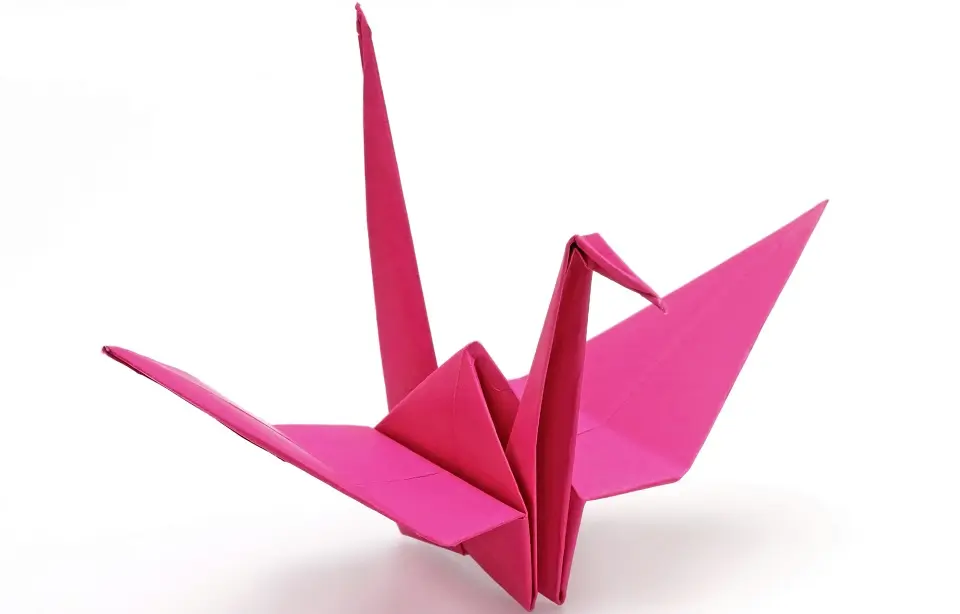

The origin of origami is in its traditional forms, many of which have been passed down through generations.
The traditional form usually involves simple, elegant models of animals or objects. These designs often use a single piece of square paper, with the most famous example being the Japanese crane, or “Orizuru.” Traditional origami focuses on simplicity, beauty, and a connection to cultural history.
2. Modular Origami
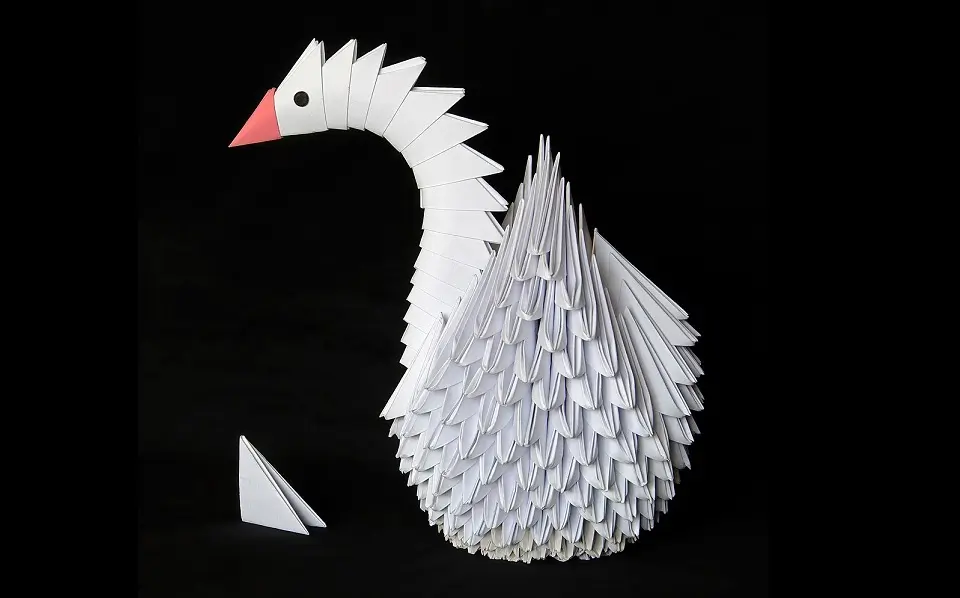

Modular origami, also known as Unit origami, involves folding multiple identical pieces of paper, or ‘modules,’ which are combined to form a more complex structure.
This style is fascinating as it explores the collective strength of individual units and often results in striking geometric formations. A well-known example of modular origami is the Sonobe ball.
3. Wet-Folding Origami
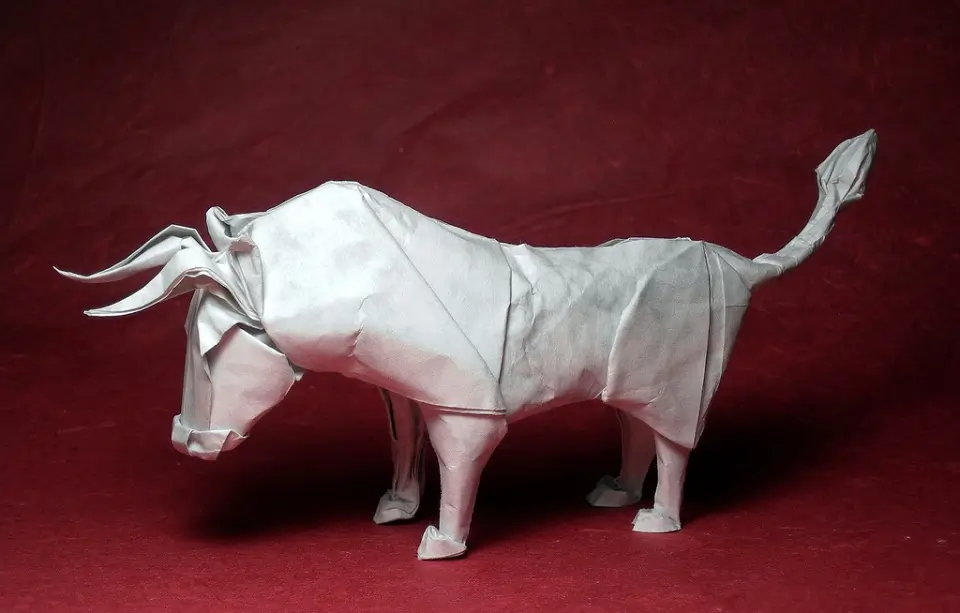

Developed by origami master Akira Yoshizawa, wet-folding involves dampening the paper before folding it, allowing for softer, more rounded shapes than the sharp creases found in most origami. This style allows for more sculptural and realistic models to make models of animals and flowers.
4. Kirigami
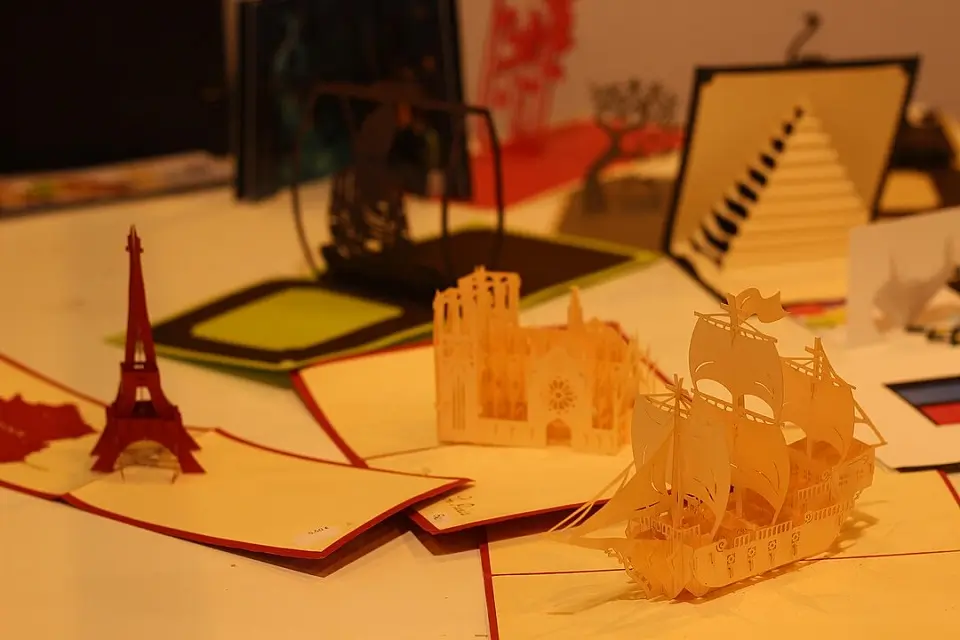

Although not strictly origami, kirigami is a related art form that involves folding and cutting paper to create models. While traditional origami often prefers folding alone to create shapes, kirigami embraces the addition of cuts to add detail and complexity to a model.
5. Pureland Origami
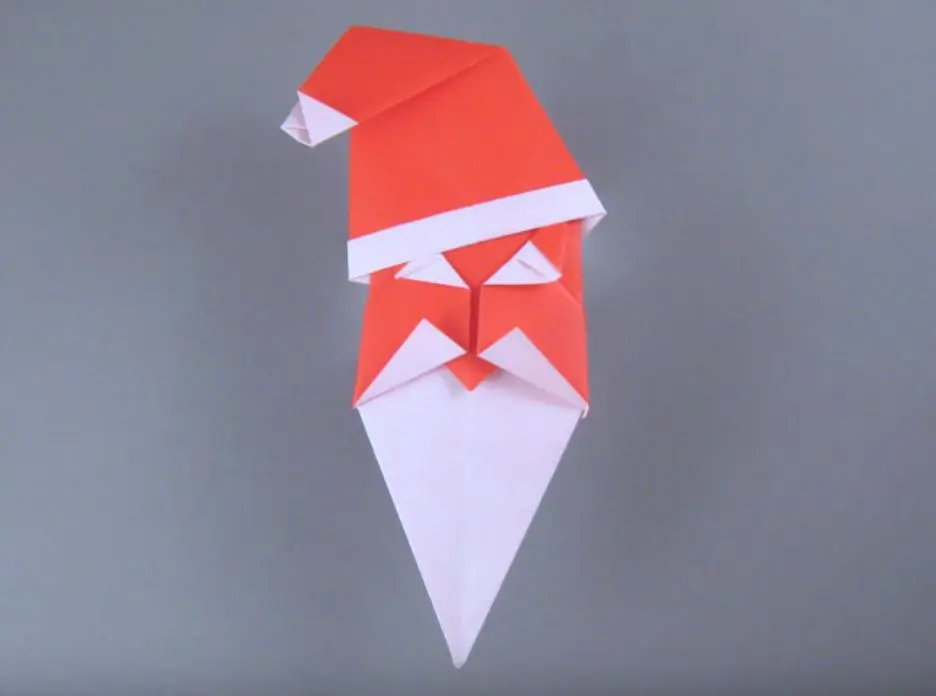

British origamist John Smith developed the Pureland origami style to make it more accessible to beginners. It restricts the types of folds to simple mountain and valley folds, and each step involves only one-fold. It limits complexity but can still create surprisingly intricate models.
6. Tessellation Origami
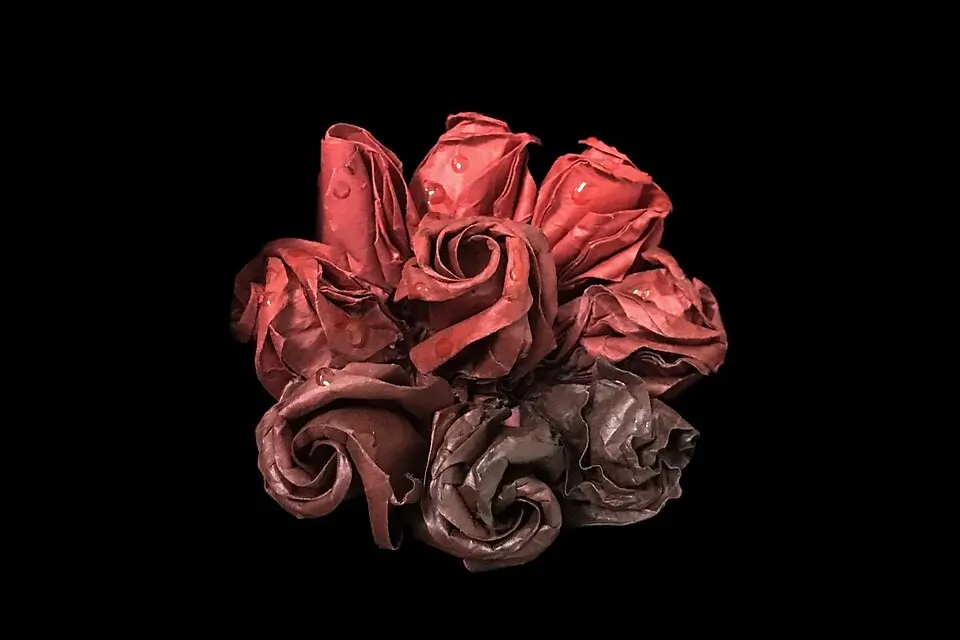

This is a more modern, complex origami-style involving folding a sheet of paper into a repeating pattern, much like tessellations in mathematics. This style often results in intricate and beautiful geometric patterns and is more about the process and pattern than the final model.
7. Origami Sekkei (Technical Origami)
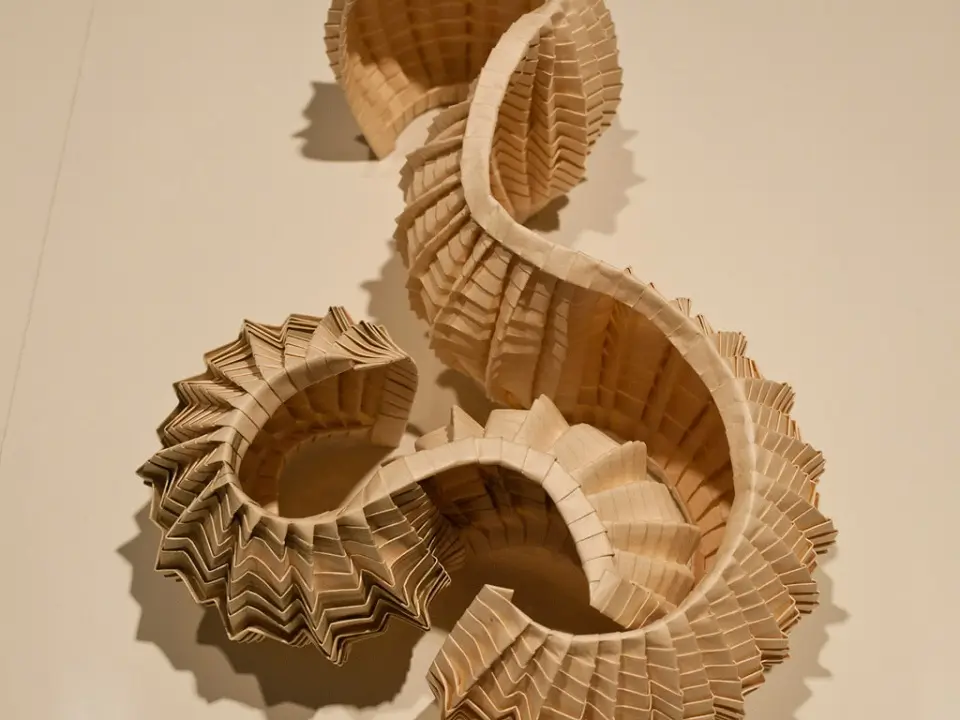

Origami Sekkei (折り紙設計), a more technical and mathematical approach to the art, is for design creations from an understanding of mathematical principles and may require complex folding sequences.
This style often aims for highly realistic models. The Sekkei designs are for everything from artistic expression to practical applications in fields like engineering and space science.
Final Words About Origami Types
Each of these types of origami has its unique philosophy, technique, and result, illustrating the versatility and depth of this art form.
Some artists may specialize in one type or use techniques from several to create their models. In all cases, origami remains an art of transformation, taking a simple sheet of paper and turning it into something beautiful and unexpected.
Techniques and Type of Folds
Origami, as an art form, has developed a range of techniques that have been standardized and are universally employed. These techniques serve as the foundation for virtually all types of origami, from the simplest to the extraordinarily complex.
1. Basic Folds
Mountain and Valley Folds
These are the most basic folds, the building blocks of origami. A mountain fold forms a peak with a crease at the top, like a mountain ridge, while a valley fold creates a dip with a crease at the bottom, resembling a valley.
To better imagine the mountain fold, think of folding a piece of paper in half so that the crease forms a peak like a mountain ridge. Now imagine folding a piece of paper in half so the crease forms a dip or “valley.”
Petal Folds
This technique involves creating a three-dimensional ‘petal’ or ‘flap’ from a flat square or rectangle of paper. It’s an essential technique for traditional models like the crane.
Imagine folding a piece of paper into a kite shape, then folding the top point of the ‘kite’ down. When you unfold that last fold and open the paper, it’ll resemble a petal.
Rabbit Ear Fold
This fold involves making three folds at once to create a ‘rabbit ear,’ a point sticking up out of the paper that resembles, as the name suggests, a rabbit’s ear.
For a rabbit ear fold, take a square piece of paper and make a diagonal fold, then open it up. Now fold both sides of the square to the center crease you just made. The result is a “rabbit ear” popping up.
2. Advanced Folds
Sink Folds:
This origami technique involves collapsing a portion of the paper inward. It’s a more complex technique that creates more detailed shapes and structures in the model.
A ‘sink fold’ is a bit tricky without a visual, but let’s try. Make a square base. Open the top layer of paper and then fold the sides along existing creases, like you’re tucking it into itself. That’s a basic open sink fold.
Pleats and Crimps
“Pleats and Crimps” techniques involve multiple parallel folds close together to create texture and detail, much like pleating in fabric.
To understand “pleats and crimps” origami techniques, think of making a fan with a piece of paper. You’re folding the paper back and forth along parallel lines. That’s a pleat. A crimp is like a pleat but with just one back-and-forth fold.
3. Origami Bases
Most origami models start with a base, a sequence of folds that creates a flexible structure to build upon.
Square Base (Preliminary Base)
One of the most common bases in origami, the square base, forms a square shape with four flaps.
Let’s see how to make a square base:
To make a square base, also called a preliminary base, take a square piece of paper and make two diagonal folds (valley folds). Open up and then fold horizontally and vertically (mountain folds). Now, pick the paper up and bring all the corners together. Flatten it. That’s your square base.
Steps to Make a Square Base Origami
- Start with a square piece of paper. If you’re using paper with one colored side and one white side, start with the colored side face down.
- Create diagonal creases by folding the paper diagonally in half, one way, then the other way. You should have two creases forming an ‘X’ shape on the paper.
- Create horizontal and vertical creases by folding the paper in half side-to-side and then top-to-bottom. When you unfold the paper again, it should have four lines intersecting in the middle, half of them diagonal and half straight.
- Collapse the paper along the creases to form the square base. With the colored side facing up, fold along one of the diagonal creases. The paper should naturally collapse along the existing horizontal and vertical creases, resulting in a smaller square shape with two ‘flaps’ on the left and right sides.
You may check the video for the process of making a square base here.
Bird Base Origami
The Bird base is slightly more complex than many traditional models, including the classic crane.
To make a bird base Origami, make a square base. Fold both layers of the top flap towards the center line and unfold. Then, fold the top corner down and unfold. Now, lift the first layer upwards, and the sides will naturally come inwards. Flatten it down, and repeat on the other side.
Step-by-step Guide to Make Bird Base:
- Start with the square base: Take a square piece of paper, ideally with different colors on each side. Begin with the color you want for your final bird on the bottom. Create the diagonal, horizontal, and vertical creases, and collapse the paper into smaller square shapes.
- Fold to the center line: Fold the top layer of the bottom corner up to the top corner. This should divide your shape in half. Unfold the paper back into the square base.
- Fold the sides: Fold the top layer’s left and right corners into the center line, aligning with the crease you made. This forms a kite shape.
- Fold the top triangle down: Now fold the top triangle of the top layer down over the edges of the two flaps you folded in step 3. Now, you have a diamond shape on top of a triangle.
- Unfold the last three steps: Unfold the folds you made in steps 2, 3, and 4 to return to the square base.
- Perform a petal fold: Lift the bottom corner of the top layer, folding along the creases you made in the previous steps. The left and right corners should fold inward, collapsing along the existing creases. This makes a petal fold that looks like an elongated diamond on top of a square.
- Repeat: Turn the model over and repeat steps 2 to 6 on this side. Your model should now look like a kite with two ‘legs’ at the bottom.
- Fold the ‘legs’ inwards: Fold the ‘legs’ of the kite inward to align with the center crease, creating a narrower kite shape.
- Fold the model in half: Fold it in half along the center crease to look like a narrower and taller kite.
You can check the process to make a Bird Base here.
Use of Bird Base
The Bird base is the starting point for many bird and flower models, including the famous crane. The techniques used here, such as the petal fold, are common in many other origami models, demonstrating the building-block nature of origami.
Frog Base Origami
The Frog base is an advanced base that allows for more complex models, including many animals.
Fold the top flaps into the center for a frog base origami, then unfold. Lift the top layer and fold the sides along the creases like an inverted petal fold. Repeat on the other side. You may please check the Frog Base folds here.
Step-by-step Process for Frog Base:
- Start with a bird base: The frog base starts from a bird base. If you’re unsure how to make a bird base, please refer to the previous response for step-by-step instructions.
- Fold the edges to the center line: Hold the model with the two ‘legs’ at the bottom once you have your bird base. Take the top layer of the bottom edge and fold it up to meet the top point. Repeat this on the other side.
- Fold the top triangle down: Fold the small triangle at the top down over the two edges folded in the previous step.
- Unfold the last two steps: Now, you will unfold the folds you made in steps 2 and 3 to return to the bird base.
- Perform an inside reverse fold: You’ll see a horizontal crease along the top of the figure from your previous folds. You’ll perform an inside reverse fold along this crease. Lift the top layer from the bottom point and pull it upwards, reversing the creases on the sides and folding them inward. The model should now resemble a tall diamond with ‘legs’ on the bottom.
- Fold the ‘legs’ inwards: Now, you will take the bottom ‘legs’ and fold them inward to the center line, similar to the steps in the bird base.
- Fold in half: Fold the model in half along the center line so it looks like a narrow, tall diamond.
- Repeat on the other side: Flip the model over and repeat steps 2 to 7 on this side.
Use of Frog Base Origami
Origami artists use the Frog Base for more complex models, such as a traditional frog, or even intricate models like an origami phoenix.
The skills and techniques used in creating this base, such as inside reverse folds and petal folds, are fundamental to many aspects of origami, especially more advanced models. As always, patience and precision are the keys to beautiful art!
Waterbomb Base Origami
A waterbomb base forms a hollow diamond shape, and Origami artists often use it for models that need to inflate or have a round shape.
Steps to make Waterbomb base:
- Fold the top layer: Fold the top layer of the bottom corner up to the top corner, folding the model in half.
- Repeat on the other side: Flip the model over and repeat the previous step on this side. The model should now look like a smaller square with two flaps sticking out on the left and right sides.
- Collapse into the base: At this point, you can transition into the Waterbomb Base. Grasp the model at the left and right tips and lift it slightly. Then, push the top down to the bottom while bringing the left and right tips together. The model will naturally collapse into the shape of a triangle. Flatten it down well.
The waterbomb base is one of the most common and versatile origami bases, often used as the starting point for models such as balloons (also known as water bombs, hence the name), lanterns, and various animals. You can check a video to make a Waterbomb base here.
Remember, origami is not just about the techniques; it’s about the journey of creation. The same set of techniques can lead to a limitless array of creations.
It combines precision, creativity, patience, and sometimes even intuition. Whether you’re creating a simple boat or an intricate dragon, the core techniques remain the same, proving that complexity can arise from simplicity.
Famous Origami Models
These models are well-known for their elegance, iconic design, and the complexity of the folding techniques. These include:
1. Crane (Orizuru)
Perhaps the most famous origami model of all, the crane, or “orizuru,” is a classic symbol of peace and longevity in Japanese culture. According to legend, gods grant a wish to anyone who folds a thousand origami cranes.
Crane of orizuru model is often associated with the story of Sadako Sasaki, a young girl affected by the atomic bombing of Hiroshima, who sought to fold a thousand cranes in hopes of recovering from her illness.
2. Flapping Bird
The flapping bird is another traditional origami model famous for its dynamic design. When you pull the tail of the finished model, the bird appears to flap its wings. It’s a delightful example of action origami, where the model can move or change shape.
3. Jumping Frog
Another example of action origami, the jumping frog, is a fun and interactive model. When completed, you can press down on the frog’s back and release it, causing the frog to leap off the table. It’s a favorite among children and beginners due to its simplicity and interactive results.
4. Kusudama Flower
The Kusudama Flower is a popular model in modular origami. We can assemble five or six of these flowers into a ‘Kusudama‘Ball. Kusudama, in Japanese, means ‘medicine ball,’ and they were traditionally used for incense or potpourri. Today, we can often see them as decorations or gifts.
5. Kawasaki Rose
Named after its creator, Toshikazu Kawasaki, the Kawasaki Rose is a beautiful and intricate origami model. People admire its realistic form and the complexity of the folding sequence. There are several variations of the model, some including leaves and stems.
6. Origami Dragon
Origami dragons can range from simple to complex models. However, the intricate ones are often considered a test of an artist’s skills. Detailed models can feature everything from claws, wings, and tails to the dragon’s characteristic scales.
7. Magic Ball (Dragon’s Egg)
This model is a striking example of origami tessellation. This model is also known as the Dragon’s Egg. Created by Yuri Shumakov, it’s made from a single sheet of rectangular paper and involves creating a detailed tessellated pattern before collapsing the paper into the final three-dimensional shape.
These are just a few examples of the many unique and exciting models we can create. Each model tells a story or represents something from the real world, demonstrating the transformative power of this art form. From delicate flowers to mighty dragons, origami brings life to a simple piece of paper.
Origami and Mathematics
Origami, at its core, is about transformation – taking a simple, flat piece of paper and transforming it into a three-dimensional object of beauty or complexity through a series of folds. At first glance, it may seem like pure artistry, but delve a bit deeper, and you’ll discover that origami is steeped in mathematics.
Geometry and Origami
The fundamental connection between origami and mathematics lies in geometry. Origami designs are often symmetrical, which lends itself to the principles of geometry.
Each fold of this art is a geometric operation, transforming the paper from one shape into another, from the simplest model to the most intricate. In advanced origami, we can divide a single piece of paper into hundreds or thousands of smaller shapes that fold together in complex ways.
Algebra and Origami
When creating an origami model, the artist often needs to divide the paper into fractions (halves, thirds, quarters, etc.).
These divisions, while creating an Origami, naturally involve the principles of algebra. This became evident in the 1980s when origami artist Robert Lang and others developed an origami notation system (essentially an algebra of paper folding) to help describe complex folding sequences.
Origami and the Art of Problem Solving
We can also view Origami as a form of problem-solving, a key skill in mathematics. The artist starts with a goal (the finished model) and must figure out a sequence of folds to achieve that goal. This resembles how a mathematician must solve a complex equation or prove a theorem.
Design Algorithms
With the rise of computational origami, algorithms are now used to design origami patterns.
Algorithms, which are step-by-step procedures for calculations, have been developed to take any 3D shape and turn it into a foldable 2D pattern, bringing origami, computer science, and mathematics together.
This field has practical applications in areas such as airbag design and space science, where we need to compact objects for transport and unfold them once they reach their destination.
Origami and Mathematical Theorems
The connection between mathematics and origami goes even deeper with the development of mathematical theorems that originate from this art form.
The most notable example of this is the Huzita–Hatori axioms. This is also known as the origami axioms, which are a set of seven axioms (rules) that describe the mathematical properties of the folds that can be made while creating an origami model.
In conclusion, origami is a wonderful confluence of art and mathematics. It’s a testament to how artistic creativity and scientific analysis can coexist and enhance and inform each other in unexpected ways.
Whether folding a simple paper crane or designing a complex tessellation, origami invites you to engage your creativity and mathematical thinking.
Origami in Entertainment, Literature, and Business
Origami has enjoyed a rich presence in popular culture, appearing in a diverse range of films, books, television series, and other forms of media. Its elegance, depth, and aesthetic appeal make storytelling and visual design popular. Below are a few notable instances of the same:
1. Film and Television
Origami has made numerous appearances in film and television, often as a symbol or plot device.
In the film “Blade Runner,” a small origami unicorn left by a character, Gaff, becomes a significant symbol. Similarly, in the “Star Trek” universe, Hikaru Sulu is shown folding paper cranes. In “Prison Break,” the character Michael Scofield uses an origami swan to communicate covertly.
Animated films have also utilized origami, such as “Kubo and the Two Strings,” where this art is central to the plot. The main character, Kubo uses magical origami for storytelling and his adventures.
2. Literature
Origami has been featured in several books as well. “Sadako and the Thousand Paper Cranes” by Eleanor Coerr tells the story of Sadako Sasaki, a young girl in post-war Hiroshima who attempts to fold a thousand cranes after hearing the legend that doing so will grant a wish.
The art form also shows up in more lighthearted contexts. In the children’s book series “Origami Yoda” by Tom Angleberger, a finger puppet made from folded paper provides wisdom and advice.
3. Music
In music, origami has appeared in album art and music videos. Björk’s music video for “Hidden Place” features intricate paper sculptures, and Coldplay’s “Strawberry Swing” video showcases stop-motion animation with chalk drawings and origami.
4. Video Games
Video games have also begun to embrace origami. “Heavy Rain,” an interactive drama and action-adventure game, uses an origami figure as a key symbol in its narrative.
More recently, Nintendo’s “Paper Mario: The Origami King” utilizes this art as a central theme, with characters, enemies, and parts of the world made from folded paper.
5. Advertising and Branding
Given its visual appeal, origami has also been used in advertising and branding. Companies like Adidas and Mitsubishi have used this art in their ad campaigns, and the software company Adobe uses an origami butterfly as a loading icon.
Origami’s appearances in pop culture are as varied as the art form itself. It’s used as a symbol, a plot device, a thematic element, and even a form of visual art. Its elegance and intricacy lend a touch of beauty to any medium, whether it’s a film, book, song, or video game.
In Science and Technology
Origami’s influence extends beyond arts and crafts, reaching into science and technology.
The fundamental principles of this art, which involve transforming a two-dimensional sheet into a three-dimensional structure through folding, have been adopted by various scientific disciplines.
Here’s how the origami art form finds its applications in science and technology:
1. Space Exploration
Scientists have exploited the compactness of a folded origami model to solve the problem of transporting large objects into space, where payload space is at a premium.
The most famous example is probably the solar array on Japan’s Space Flyer Unit, launched in 1995, which was folded using origami principles.
NASA has also been exploring origami designs for its spacecraft, including folding structures for large solar panels and telescopes.
2. Medicine and Biology
In the medical field, origami has found applications in designing compact surgical instruments that can unfold inside the body, minimizing the invasiveness of certain procedures.
Drug delivery systems, which release pharmaceuticals at a controlled rate in the body, are another area where origami techniques are being investigated.
Origami also influences the study of protein folding in biology. Understanding the principles of how paper folds and unfolds can provide insight into how proteins do the same thing, which is essential for understanding diseases like Alzheimer’s and Parkinson’s, where protein misfolding is a factor.
3. Engineering
Engineers have applied origami techniques to design foldable and deployable structures, ranging from tiny micro-robot components to larger structures like bridges or emergency shelters for disaster relief. Origami’s principles allow these structures to be stored compactly and deployed when needed.
4. Nanotechnology
At the nanoscale, scientists use origami principles to design and build complex structures from DNA, creating shapes such as tubes, boxes, and even nanoscale robots. This field, known as DNA origami, could have significant implications for medicine, electronics, and materials science.
5. Robotics
Origami has inspired a field known as “origami robotics.” These robots can fold themselves into different shapes, allowing them to perform various tasks, like gripping objects or crawling. Since they can be folded flat, they can also be transported easily, making them useful for tasks in challenging or remote environments.
In all these applications, origami’s primary strength is its ability to transform a large, flat object into a smaller, complex one.
As we continue to develop our understanding of origami, we’ll likely see its use in even more innovative and surprising ways in science and technology. It’s a testament to the versatility and relevance of this ancient art form in the modern world.
Therapeutic Uses of Origami
Origami is more than just a creative activity. Its process combines focus, coordination, and creativity and has proven beneficial in various therapeutic settings.
1. Mental Health Therapy
Origami is frequently used as a form of art therapy to help individuals express feelings and thoughts that may be difficult to articulate verbally.
The act of creating can be a non-threatening medium for expression and can help lower stress and anxiety. It can be used in therapy sessions to promote mindfulness and relaxation, as the process requires focus on the present moment, much like meditation.
2. Physical Rehabilitation
Origami can be used in physical rehabilitation to encourage fine motor skill development and hand-eye coordination.
For individuals recovering from strokes or accidents or those with conditions such as arthritis, the delicate folds and precision required in origami can be an effective form of physiotherapy. The achievable goals set through creating an origami piece can also improve self-esteem and motivation in recovery.
3. Educational Tool
Origami often finds its application as an educational tool to help children develop skills such as concentration, sequencing, and spatial awareness.
Following the steps to complete an origami model, children can improve their ability to focus, plan, and execute a task. It’s also a tactile way to teach geometric principles and understand three-dimensional shapes.
4. Social Skills
In group settings, origami can serve as a social activity, fostering communication and cooperation. In schools or community gatherings, it can be used as a collaborative project to foster teamwork. The sharing of origami skills can also help to boost self-esteem and confidence.
5. Emotional Healing
On an emotional level, origami can provide a sense of peace and accomplishment.
The story of Sadako Sasaki, a young girl who aimed to fold 1,000 cranes while battling leukemia in the wake of the Hiroshima bombing, illustrates the hope and resilience that can be found in the process of folding paper. Today, making paper crane origami is seen as a symbolic gesture of peace and healing.
6. Cognitive Improvement
Research has also suggested that origami can have cognitive benefits. By engaging both brain hemispheres, origami can aid cognitive development and functioning. Combining creativity and logical sequencing can help improve memory, focus, and spatial skills.
Origami’s therapeutic uses demonstrate that this ancient art form can create beautiful objects and promote well-being and healing. Its combination of creativity, focus, and tactile engagement makes it a versatile tool in various therapeutic and educational contexts.
Famous Origami Artists
The world of origami boasts many talented and innovative artists who have pushed the boundaries of this ancient art form. Here’s a look at some of the most famous and influential origami artists:
1. Akira Yoshizawa (1911-2005)
Considered the grandmaster of origami, Akira Yoshizawa elevated origami from a craft to a living art.
He created more than 50,000 models and developed the Yoshizawa–Randlett system of notation for origami folds, which is now the standard. His innovative techniques, such as wet folding that allows for more sculptural models, significantly expanded the possibilities of origami.
2. Robert J. Lang
Robert Lang is a physicist and one of the leading figures in origami today, especially known for his complex, lifelike models of insects and animals.
His work combines aspects of the Western school of mathematical origami design with the Eastern emphasis on lines and forms to yield models that are at once strikingly realistic and aesthetically pleasing. Lang also made significant contributions to the mathematics of origami, including developing the “tree theory.”
3. Satoshi Kamiya
Satoshi Kamiya is a highly respected Japanese origami artist famous for his intricate designs and attention to detail.
He started creating original origami models at the age of 14, and his work often features fantastical creatures, such as dragons and phoenixes. One of his most famous works is the Ryujin, a complex and detailed origami dragon.
4. Eric Joisel (1956-2010)
Eric Joisel was a French origami artist famous for his figurative origami sculptures. His works were incredibly detailed, with pieces often featuring intricate faces and bodies to convey a sense of personality and humanity. His designs included musicians, mythological creatures, and characters from the Commedia dell’arte.
5. Tomoko Fuse
Tomoko Fuse is a prolific Japanese origami artist and author known for her work with modular origami and boxes. She has written many books on these subjects, contributing greatly to the spread of these types of origami worldwide. Her work is famous for its elegance and precision.
6. Michael LaFosse
Michael LaFosse is an American origami artist and co-founder of the Origamido Studio.
He has designed hundreds of origami models, from simple butterflies to complex figures. LaFosse is also known for focusing on the paper itself, often making his own origami paper to achieve the desired effect in his models.
7. Kade Chan
Kade Chan is a professional origami artist from Hong Kong. He started folding at a very young age and has developed a unique style that combines traditional origami techniques with his background in product design.
His designs are known for their complexity and realistic detail, with some of his most famous works including the Fiery Dragon and the Hell Cobra.
8. Won Park
Won Park is a Korean-American artist who specializes in money origami. He is famous for folding intricate models, including koi fish, cars, and buildings, using only dollar bills without any cuts, glue, or other aids. His work challenges the norms of what origami can be, using an unconventional medium to create intricate and lifelike models.
9. Hojyo Takashi
Hojyo Takashi is a Japanese origami artist known for his deeply intricate and philosophical designs. His work often involves complex human figures depicting deities or religious icons.
Takashi’s models, such as his famous Maitreya (Buddha-like figure), showcase the high degree of detail and complexity that origami can achieve.
10. John Montroll
John Montroll is an American origami artist, author, and teacher who has published numerous books on origami.
His work is known for its clarity and creativity, often featuring animals and geometric shapes. He’s especially well-regarded for his contributions to the development of mathematical origami and the creation of new folding techniques.
11. Beth Johnson
Beth Johnson is an American origami artist known for her elegant, minimalist designs. She often draws inspiration from nature, creating beautiful models of animals, plants, and objects with a distinct, stylized look. Johnson’s work is known for its originality and expressive use of simple, clean lines.
12. Joseph Wu
Joseph Wu is a professional origami artist based in Vancouver, Canada. He started folding at the early age of three and later turned this passion into a career. Known for his expressive and often whimsical designs, Wu’s work covers various subjects, from animals to fantasy creatures to abstract geometric shapes.
13. Roman Diaz
Born in Uruguay, Roman Diaz is a veterinary surgeon and origami artist. His origami designs are often inspired by the natural world, particularly animals, and are known for their life-like detail and charm.
Diaz has authored several popular origami books, including “Origami for Interpreters,” which helped introduce new shaping techniques.
14. Giang Dinh
Giang Dinh, a Vietnam-born artist now based in the United States, is known for his organic and minimalist origami designs.
His work often eschews complex folds and details for simple, elegant lines, giving his models a stylized, sculptural feel. His preferred technique is wet folding, which involves dampening the paper to create soft curves and folds.
15. Toshikazu Kawasaki
Toshikazu Kawasaki is a Japanese origami artist and mathematician famous for his work on the Rose series.
His most renowned model, the Kawasaki Rose, is known for its intricate design and the mathematical theory behind it. He has written several books about the mathematics of origami and the instructions for folding complex origami figures.
16. Kunihiko Kasahara
Kunihiko Kasahara is a Japanese architect and origami expert known for his work on origami cubes and other geometric shapes. He has written numerous books on origami that cover a range of complexities, from simple traditional models to complex, multi-piece structures.
The above-mentioned Origami artists are just a few examples of the many talented individuals who have left their mark on origami. Each has expanded the possibilities of what can be achieved with a simple sheet of paper and inspired countless others to explore the art of origami.
These artists, along with many others, showcase the range and diversity of the origami art form. Their contributions have helped elevate origami from a simple pastime to a recognized art form, each bringing their unique style and perspective.
Conclusion
In conclusion, origami is more than just an art form; it’s a fascinating blend of history, culture, art, mathematics, and even philosophy.
From its ancient origins to its modern developments, origami embodies a powerful symbol of transformation and infinite potential that’s inherent in a simple piece of paper. Its intricate folds and creases hold a universal appeal that transcends borders and generations, sparking imagination and curiosity.
The various styles and techniques of origami highlight its dynamic and evolving nature, while countless innovative artists bring their unique visions and perspectives to this art form, consistently pushing its boundaries.
Moreover, origami’s influence extends beyond aesthetics and artistry. It’s employed in practical and innovative applications in education, therapy, science, and technology, demonstrating its broad versatility.
As we delve deeper into the art of origami, it’s clear that this art form is a potent testament to human creativity and ingenuity.
In the fold of a paper, we see the synthesis of simplicity and complexity, tradition and innovation, form and function.
The beauty of origami lies in the final product and the journey of transformation—the process that turns a flat, two-dimensional sheet of paper into a three-dimensional work of art. Thus, Origami invites us to rethink our perceptions of art, creativity, and possibility.
Despite its centuries-old history, the Japanese paper-folding art of origami remains a fresh, vibrant, and ever-evolving field that continues to inspire, fascinate, and surprise. As we unfold its myriad layers, we marvel at its limitless possibilities—a testament to the power of human creativity and the magic in simple paper folds.


A long-term ex-pat in Japan, Himanshu comes with an IT background in SAP consulting, IT Business Development, and then running the country operations of an IT consulting multinational. Himanshu is the co-founder and Managing Director of ReachExt K.K. and EJable.com. He is also an Advisory Board Member of a Silicon Valley AI/IoT startup.

